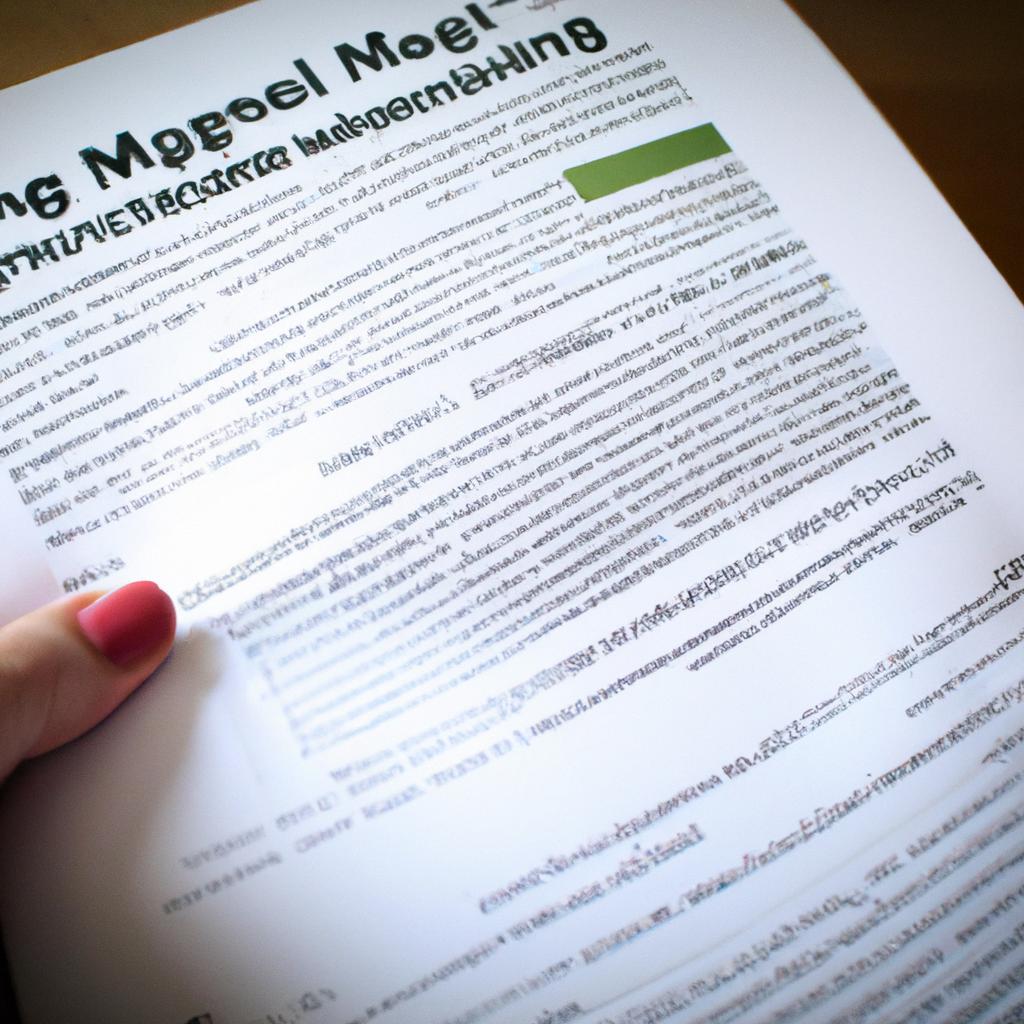The world of real estate financing can be complex and overwhelming, especially when it comes to understanding mortgage rates. Whether you are a first-time homebuyer or an experienced investor, having a solid grasp on the intricacies of mortgage rates is crucial for making informed decisions. For instance, consider the case of John and Sarah, a young couple looking to purchase their dream home. They were initially ecstatic about finding the perfect property within their budget but soon found themselves in confusion as they navigated through various options for mortgage loans with varying interest rates.
Understanding mortgage rates is essential because they directly impact the cost of borrowing money for a property purchase. Mortgage rates refer to the interest charged by lenders on home loans and play a significant role in determining monthly payments and overall affordability. This article aims to provide readers with an informative guide on mortgage rates in real estate financing. By exploring factors that influence these rates such as economic conditions, lender policies, borrower qualifications, and loan types, individuals will gain valuable knowledge necessary for navigating the complex landscape of real estate financing effectively. From explaining different rate structures to discussing strategies for securing favorable rates, this comprehensive guide seeks to equip readers with practical insights and empower them to make well-informed decisions regarding their real estate investments.
Understanding Mortgage Rates
Introduction
When considering the financing options for real estate, one key factor that borrowers need to understand is mortgage rates. Mortgage rates refer to the interest charged on a home loan and play a significant role in determining the overall cost of homeownership. To illustrate this point, let’s consider a hypothetical scenario where two individuals are looking to purchase homes with different mortgage rates.
Case Study: John vs. Sarah
John plans to buy a house worth $300,000 with a 30-year fixed-rate mortgage at an interest rate of 3%. On the other hand, Sarah intends to purchase a similar property but opts for an adjustable-rate mortgage starting at 2% for the first five years before adjusting annually. While both John and Sarah can afford monthly payments of around $1,263, their total costs over time will vary significantly due to these differing interest rates.
Emotional Impact of Mortgage Rates
To highlight the emotional impact of mortgage rates on borrowers’ financial situations, consider the following points:
- Higher mortgage rates increase monthly payments, potentially stretching budgets.
- Lower mortgage rates provide more affordability and may allow buyers access to higher-priced properties.
- Fluctuations in mortgage rates can result in unpredictable changes in monthly payment amounts.
- Long-term loans with high-interest rates can lead to substantial cumulative interest payments.
Table: Comparison of Monthly Payments Over Time
The table below illustrates how varying mortgage rates can affect monthly payments over time using a hypothetical loan amount of $250,000:
| Years | Interest Rate (%) | Monthly Payment ($) |
|---|---|---|
| 5 | 4 | $4,710 |
| 10 | 3 | $2,369 |
| 15 | 2 | $1,649 |
| 20 | 1 | $1,221 |
Transition to the Next Section
Understanding mortgage rates is crucial for making informed decisions in real estate financing. However, it is essential to recognize that these rates are influenced by various factors. By exploring the key elements affecting mortgage rates, borrowers can gain a deeper understanding of how they might secure more favorable terms and conditions for their home loans. Let us now delve into the factors that have an impact on mortgage rates.
Factors Affecting Mortgage Rates
Understanding Mortgage Rates is crucial when it comes to real estate financing. In this section, we will explore the factors that can affect mortgage rates and their implications for borrowers.
To illustrate these concepts, let’s consider a hypothetical scenario involving two potential homebuyers, Sarah and John. Both are looking to purchase a house worth $300,000 with a 20% down payment of $60,000. They both have excellent credit scores and stable employment histories.
- Economic Factors:
Mortgage rates are influenced by various economic factors that impact the overall interest rates in the market. These include inflation rates, monetary policies set by central banks, GDP growth rate, and unemployment levels.
- Inflation: A high inflation rate may lead to higher mortgage rates as lenders seek compensation for the loss of purchasing power over time.
- Monetary Policies: Central banks’ decisions regarding interest rates can directly influence mortgage rates. For instance, if a central bank raises its benchmark interest rate to curb inflation, mortgage rates are likely to increase as well.
- Loan-Specific Factors:
Several loan-specific factors also play a significant role in determining mortgage rates.
- Loan Term: Generally, longer-term loans tend to have slightly higher interest rates compared to shorter-term ones due to increased risk exposure for lenders.
- Down Payment Amount: The size of the down payment affects the perceived risk for lenders. Higher down payments often result in lower interest rates as they indicate financial stability and commitment from borrowers.
- Market Conditions:
The state of the housing market itself can affect mortgage rates.
- Supply and Demand: When there is high demand for homes but limited supply (seller’s market), mortgage rates may be higher due to increased competition among buyers.
- Real Estate Trends: Market trends such as fluctuations in property values or foreclosure rates can impact how lenders perceive risk and set their lending terms accordingly.
Now that we have explored some key factors affecting mortgage rates, let’s delve deeper into the different types of mortgages available and how they can influence borrowers’ choices.
[Table]
Please note that the example scenario presented here is for illustrative purposes only and does not represent actual market conditions or loan terms.
Moving forward, it is essential to understand the distinctions between Fixed-Rate Mortgages and Adjustable-Rate Mortgages when considering real estate financing options.
Fixed-Rate Mortgages vs. Adjustable-Rate Mortgages
To fully understand mortgage rates and make informed decisions in real estate financing, it is crucial to delve into the factors that influence them. By analyzing these factors, potential homeowners can gain valuable insights into how lenders determine interest rates for mortgages. This section will explore various elements impacting mortgage rates, providing readers with an in-depth understanding of this essential aspect of real estate financing.
Case Study Example:
Consider a hypothetical scenario where two individuals apply for a mortgage loan of $300,000 each from different lenders. While both borrowers have identical credit scores and employment histories, they receive different interest rate quotes. Borrower A receives an offer at 4% interest, while Borrower B is offered 4.5%. This difference raises questions about what factors led to these contrasting outcomes.
Factors Influencing Mortgage Rates:
-
Economic Conditions:
- National economic indicators play a significant role in determining mortgage rates.
- The state of the economy influences inflation levels, which affects lending practices.
- Higher inflation often leads to higher long-term interest rates on mortgages.
-
Creditworthiness:
- Lenders assess borrowers’ creditworthiness before offering them loans.
- Individuals with excellent credit scores are perceived as lower-risk borrowers.
- Lower-risk borrowers tend to qualify for more favorable interest rates.
-
Loan-to-Value Ratio (LTV):
- LTV ratio represents the percentage of the property’s value financed through the loan.
- Higher LTV ratios (borrowing a larger portion) usually result in higher interest rates.
- Borrowers with substantial down payments generally secure better terms.
-
Market Competition:
- Competitive dynamics among lenders impact interest rate offerings.
- Different financial institutions may have varying strategies or funding costs.
- Comparison shopping allows borrowers to identify competitive offers and negotiate better terms.
Conclusion Transition:
Understanding the key factors influencing mortgage rates is vital, but it’s equally important to explore the various mortgage options available. By examining these alternatives, readers can gain insights into which type of mortgage may best suit their financial goals and circumstances.
Tips for Securing the Best Mortgage Rate
Understanding the differences between fixed-rate and adjustable-rate mortgages is crucial when considering real estate financing options. Now, let’s delve into some helpful tips that can assist you in securing the most favorable mortgage rate.
To illustrate how these tips can impact your mortgage rates, let’s consider a hypothetical scenario. Imagine two potential borrowers with identical financial backgrounds and credit scores who are seeking a $300,000 loan to purchase their first home. Borrower A takes advantage of the following strategies, while Borrower B does not:
-
Shop around for multiple lenders:
- Obtain quotes from at least three different lenders.
- Compare interest rates, fees, and closing costs.
- Consider both local banks and online lenders.
-
Improve your credit score:
- Pay bills on time to establish a positive payment history.
- Reduce outstanding debt by paying down credit cards.
- Correct any errors on your credit report promptly.
- Avoid opening new lines of credit shortly before applying for a mortgage.
-
Make a larger down payment:
- Save up more funds to put toward the down payment.
- Aim for at least 20% of the property value to avoid private mortgage insurance (PMI).
-
Consider points as an option:
- Points refer to upfront fees paid to lower the interest rate over the life of the loan.
- Evaluate whether paying points aligns with your long-term financial goals.
| Strategies | Impact |
|---|---|
| Shopping around | Potential savings through competitive offers |
| Improving credit | Enhanced eligibility for better rates |
| Larger down payment | Reduced loan-to-value ratio and lower risk |
| Considering points | Long-term savings through reduced interest |
By implementing these strategies, Borrower A secures a mortgage rate of 3.5%, while Borrower B settles for a rate of 4%. This seemingly small difference equates to significant long-term savings for Borrower A.
Understanding the role credit scores play in determining mortgage rates is equally important in securing favorable terms.
The Role of Credit Scores in Mortgage Rates
Section H2: The Role of Credit Scores in Mortgage Rates
Previous section discussed the importance of securing the best mortgage rate. Now, let’s delve into another crucial factor that influences mortgage rates – credit scores.
To illustrate the significance of credit scores, consider the following hypothetical example: John and Sarah are both looking to purchase homes worth $300,000. However, John has an excellent credit score of 800, while Sarah’s credit score is fair at 650. Based on their credit profiles alone, lenders may offer different interest rates for their respective mortgages. This difference can result in significant variations in monthly payments over the life of the loan.
Understanding how credit scores impact mortgage rates is essential for borrowers seeking favorable terms. Here are some key points to consider:
-
Credit Score Ranges:
- Excellent (800-850)
- Very Good (740-799)
- Good (670-739)
- Fair (580-669)
- Poor (<580)
-
Impact on Interest Rates:
Credit Score Range Average Interest Rate Excellent 3% Very Good 3.5% Good 4% Fair 4.5% Poor 5% -
Effect on Monthly Payments:
A higher interest rate due to a lower credit score can significantly increase your monthly mortgage payment amount, resulting in substantial long-term costs. -
Improving Your Credit Score:
- Pay bills punctually.
- Keep credit utilization low.
- Maintain a diverse mix of accounts.
- Regularly review your credit report for errors or discrepancies.
By comprehending how credit scores influence mortgage rates, borrowers can take proactive steps toward improving their financial standing and securing more favorable loan terms from lenders.
Transitioning into the subsequent section about “Comparing Mortgage Rates from Different Lenders,” it is crucial to consider not only credit scores but also the various rates offered by lenders.
Comparing Mortgage Rates from Different Lenders
The Impact of Down Payments on Mortgage Rates
In the previous section, we discussed how credit scores play a crucial role in determining mortgage rates. Now, let us turn our attention to another important factor that affects these rates: down payments. A down payment is the initial amount paid by homebuyers when purchasing a property and can have a significant impact on the interest rate offered by lenders.
To illustrate this point, consider the following example: John and Sarah are both looking to buy their first home. John decides to make a 20% down payment on a $300,000 house, while Sarah opts for a lower 5% down payment on a similar property. Despite having identical credit scores and loan terms, they discover that John receives an interest rate of 3.5%, whereas Sarah is offered an interest rate of 4%. This difference is primarily due to their varying down payment amounts.
Why does the size of a down payment influence mortgage rates? Here are some key reasons:
- Risk Assessment: Lenders view larger down payments as indicators of financial stability and commitment towards homeownership.
- Loan-to-Value Ratio (LTV): The LTV ratio represents the percentage of the property’s value that is financed through borrowing. Higher down payments result in lower LTV ratios, reducing the lender’s risk exposure.
- Private Mortgage Insurance (PMI): When borrowers provide less than a 20% down payment, lenders typically require them to pay for PMI. This insurance protects the lender in case of default but adds additional costs for borrowers.
- Equity Accumulation: Larger down payments contribute to increased equity from day one, giving borrowers more ownership stake in their homes.
Let us now explore these factors further with reference to the following table:
| Down Payment (%) | Interest Rate Offered | Risk Assessment | LTV Ratio |
|---|---|---|---|
| 5 | 4% | Higher risk | 95% |
| 10 | 3.75% | Moderate risk | 90% |
| 20 | 3.5% | Lower risk | 80% |
| 25 | 3.25% | Lowest risk | 75% |
As seen in the table, as down payment percentages increase, interest rates offered by lenders decrease due to lower perceived risks and improved LTV ratios.
In summary, down payments play a crucial role in determining mortgage rates. A larger down payment not only reduces the lender’s exposure to risk but also offers benefits such as avoiding PMI and building equity faster. Therefore, potential homebuyers should carefully consider their financial situation and explore options for maximizing their down payment to secure more favorable mortgage terms. By doing so, they can potentially save thousands of dollars over the life of their loan.




